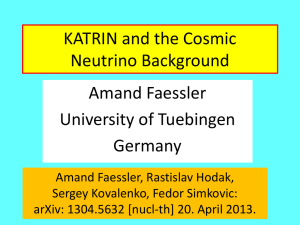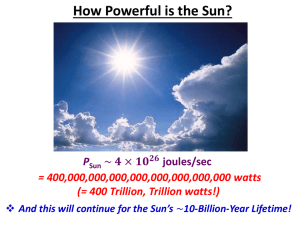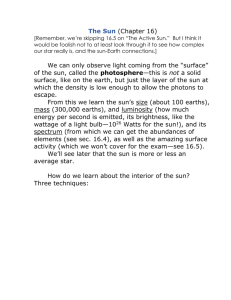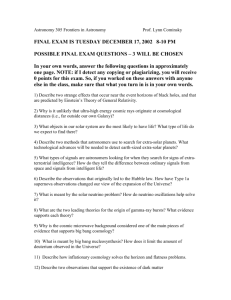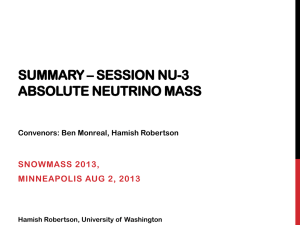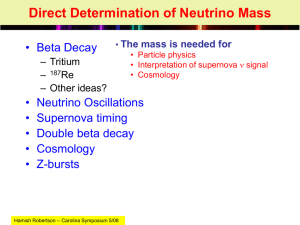Search for the Cosmic Neutrino Background
advertisement
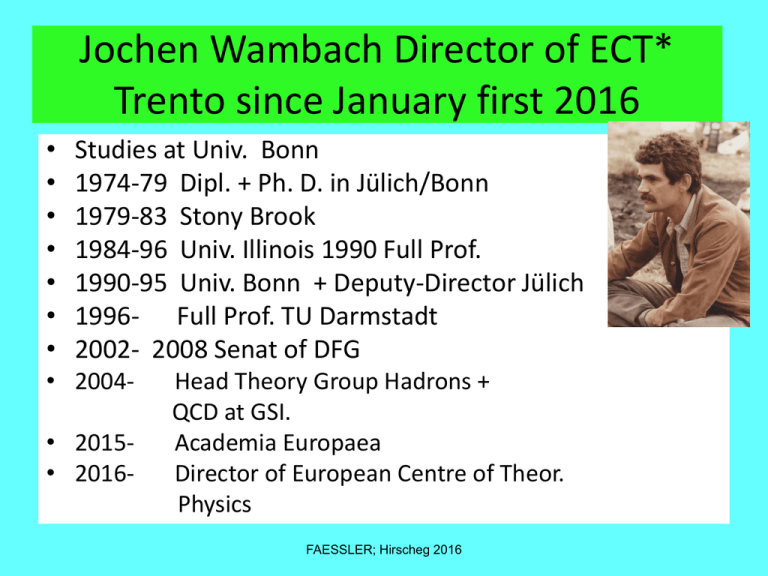
Jochen Wambach Director of ECT* Trento since January first 2016 • • • • • • • Studies at Univ. Bonn 1974-79 Dipl. + Ph. D. in Jülich/Bonn 1979-83 Stony Brook 1984-96 Univ. Illinois 1990 Full Prof. 1990-95 Univ. Bonn + Deputy-Director Jülich 1996- Full Prof. TU Darmstadt 2002- 2008 Senat of DFG • 2004- • 2015• 2016- Head Theory Group Hadrons + QCD at GSI. Academia Europaea Director of European Centre of Theor. Physics FAESSLER; Hirscheg 2016 The successful Nuclear Physics Football (Soccer) Team in Jülich-Broich ~1977 Faessler K. W. Schmid Müther, Grümmer Krewald Wambach Meyer ter V. Osterfeld FAESSLER; Hirschegg 2016 Baur Search for the Cosmic Neutrino Background with KATRIN. Amand Faessler University of Tuebingen Germany Partially based on a common Publication: Amand Faessler, Rastislav Hodak, Sergey Kovalenko and Fedor Simkovic, J. Physics G, Conf. Ser. 580 (2015) 012040 First: Cosmic Microwave Background Radiation (Photons in the Maximum 2 mm) Decoupling of the photons from matter about 300 000 years after the Big Bang, when the electrons are captured by the protons and He4 nuclei and the universe gets neutral. Photons move freely. Today: ~550 Photons /cm3 (~340 Neutrinos/cm3; 56 left handed electron neutrinos.) Planck Satellite Temperature Fluctuations Comic Microwave Background (Release March 21. 2013) E(f) ∝ f3/[exp(hf/kBT)-1][Energy/Volume] Neutrino Decoupling and Cosmic Neutrino Background For massless and massive Neutrinos: E Radiation heated up by: e+ + e- g + g (Entropy) (Friedmann+Stefan-Boltzmann) Neutrino Decoupling G/H = ( kB T/ 1MeV)3 ~ 1 T(Neutrinos)decoupl ~ 1MeV ~ 1010 Kelvin; today: Tn = 1.95 K Time after Big Bang: 1 Second (Energy=Mass)-Density of the Universe log r Radiation dominated: r ~ 1/a4 ~ 𝑇4=Stefan-Boltzmann Matter dominated: r ~ 1/a3 ~ T3 Dark Energy a(t)~1/T 1 MeV 1 eV 3000 K 1sec 3x104y 300 000 y n dec. g dec. 8x109 y g 2.7255 K n 1.95 K 1/Temp today Measurement of the upper Limit of the Neutrino Mass in Mainz and Troisk by the Triton Beta-Decay: mn < 2.2 eV 95% C.L. Eur. Phys. J. C40 (2005) 447 Kurie-Plot 3H mn 2>0 3He + e- + (anti)ne mn2 <0 Q = 18.562 keV Electron Energy KATRIN-Spectrum in KARSRUHE. Search for Cosmic Neutrino Background CnB by Beta decay: Tritium Kurie-Plot of Beta and induced Beta Decay: n(CB) + 3H(1/2+) 3He (1/2+) + e- Infinite good resolution Q = 18.562 keV Resolution Mainz: 4 eV mn < 2.3 eV Emitted electron Resolution KATRIN: 0.93 eV mn < 0.2 eV 90% C. L. Fit parameters: mn2 and Q value meV Electron Energy 2xNeutrino Masses Additional fit: only intensity of CnB Neutrino Capture: n(relic) + 3H 3He + e- 20 mg(eff) of Tritium 2x1018 T2-Molecules: Nncapture(KATRIN) = 1.7x10-6 nn/<nn> [year-1] Every 590 000 years a count!! for <nn> = 56 cm-3 Two Problems 1. Number of Events with average Neutrino Density of nne = 56 [ Electron-Neutrinos/cm-3] Katrin: 1 Count in 590 000 Years Gravitational Clustering of Neutrinos!!!??? 2. Energy Resolution (KATRIN) DE ~ 0.93 eV Kurie-Plot Emitted electron Resolution KATRIN: 0.93 eV mn < 0.2 eV 90% C.L. Fit parameters: mn2 and Q value meV Electron Energy 2xNeutrino Masses Additional fit: only intensity of CnB Gravitational Clustering of Neutrinos R.Lazauskas,P. Vogel and C.Volpe, J. Phys.g. 35 (2008) 025001; Light neutrinos: Gravitate only on 50 Mpc (Galaxy Cluster) scale: nn/<nn> ~ nb/<nb> ~ 103 – 104; <nb>= 0.22 10-6 cm-3 A. Ringwald and Y. Wong: Vlasov trajectory simulations. Clustering on Galactic Scale possible (30 kpc to 1 Mpc) nn/<nn> = nb/<nb> ~ 106 ; (R = 30 kpc) Nncapture(KATRIN) = 1.7x10-6 nn/<nn> (year-1)= 1.7 [counts per year] Effective Tritium Source: 20 microgram 2 milligram Nncapture(KATRIN*) = 1.7x10-4 nn/<nn> (year-1)= 170 [counts per year]; Requirements: 1) Maximize the number of detected 18.6 keV electrons. 2) Conserve angular momentum for the cyclotron motion of the electrons along magnetic field lines. 3) Conserve magnetic flux. 4) Focus many 18.6 keV electrons into the transport channel to the spectrometer. General Conditions: 1) 18.6 keV Electrons should not scatter to much with the Tritium-Gas. One loses events. Optimum 20 micrograms. 2) Energy resolution of 1 eV requires a low magnetic field at the oposing electric field in the spectrometer. Only 1 eV in perpendicular cyclotron motion: Eperp/B = const 3) Magnetic flux conservation limits the source area: Asource (50 cm2)* Bsource (2 Tesla) =Aspec (100 m2; d ~10m)*Bspec(1Gauss) 4) A large magnetic field at the source required to focus as many 18.6 keV electrons into forward direction into the transport channel. Large B large magnetic flux large perpendicular area of the spectrometer. Summary 1 • The Cosmic Microwave Background allows to study the Universe 300 000 year after the BB. • The Cosmic Neutrino Background 1 sec after the Big Bang (BB): Tn(today) = 1.95 Kelvin Summary 2 1. Average Density: nne = 56 [ Electron-Neutrinos/cm-3] Katrin: 1 Count in 590 000 Years Gravitational Clustering of Neutrinos nn/<nn> < 106 1.7 counts per year (2 milligram 3H 170 per year) 2. Measure only an upper limit of nn Kurie-Plot Emitted electron Electron Energy THE END 2xNeutrino Masses

